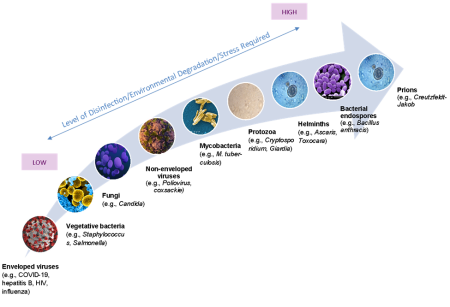The Latest Information About Covid-19 as It Relates to Biosolids
In the last issue of Biosolids Corner we summarized a few articles that were available at the time. That was fairly early in the scientific community’s learning curve about the virus. Since then, the Water Environment Federation, WEF, convened a group of renowned scientists to develop a fact sheet. The fact sheet is titled “Residuals and Biosolids Issues Concerning COVID-19 Virus” and is 19 pages long and contains 80 references. The 11 authors[1] are a who’s who in the biosolids and wastewater disinfection world and have a very high level of expertise. If you can picture them all reviewing each other’s work the final product is sure to be extremely accurate. The Fact Sheet was initially published on May 14, however, the authors are available to update as needed. So as of August 19th, this is the latest and greatest information available on the subject. The following excerpts from the Fact Sheet were selected based on what readers need to know and leaves out a lot of the scientific information.
Covid-19 Fact Sheet Summary
Because the COVID-19 virus is more susceptible to treatment, including heat, no additional protective equipment or measures are required for managing properly treated biosolids. Figure 1 shows the level of treatment required for covid-19 inactivation relative to other pathogens. You can post the image at the bottom on your bulletin board at work to cheer up your coworkers.
There is no documented evidence that biosolids are a transmission source of Covid-19 either at the WRRF or when it is used as a fertilizer or soil conditioner.
The amount of Covid-19 present in wastewater is unknown and its presence has not been documented. [2]
The disinfection processes used on Class A and B biosolids have been documented to inactivate pathogens more resistant to treatment than Covid-19. Members of the coronavirus family die off rapidly in wastewater. Virus amounts decrease 99.9% within 2 to 4 days before any treatment at 23°C. Typical wastewater treatment mechanisms (primary sedimentation, trickling filter/activated sludge, disinfection or coagulation, filtration, disinfection) have been shown to achieve more than 99.9% reduction in viral load. Mesophilic anaerobic digestion reduced enteric virus number in digested biosolids by 94.4% while thermophilic anaerobic digestion reduced it to below detection limits.
Coronaviruses have been shown to survive up to 9 days on surfaces. Inactivation can be achieved with a 62% to 71% ethanol, 0.5% hydrogen peroxide, or 0.1%sodium hypochlorite within 1 minute with higher temperatures reducing survival. These disinfectants can be used to sanitize potential surface contamination that workers may come in to contact with in an WRRF.
Limited studies (Maal-Bared et al. 2020) confirmed the presence of Covid-19 RNA[3] in stool samples of 29% to 64% of positive patients. Some of the stool samples remained RNA-positive for over 3 weeks even after the resolution of symptoms. No infective virus was detected in spite of the high RNA concentrations in the feces. It is thought that the environment in the gut might inactivate the Covid-19 virus but that has not be proven. Those people with acid indigestion should feel fortunate that their gut is especially inhospitable to viruses.
Covid-19 is mostly transmitted by person-to-person contact via respiratory droplets (via coughs, sneezing, and talking) inhaled into the lungs. Some studies have shown that it can survive on some surfaces, especially when surrounded by mucous, for 9 days. There is little evidence that it is transmitted by the fecal-oral route but if it is, it would be through freshly excreted feces. Sorry to gross you out.
In untreated municipal sludge, previous studies showed genetic material from other coronaviruses in 80% of untreated sludge and Class B Biosolids. Current practices involving PPE with untreated wastewater and municipal sludge are considered to be effective but the WEF is currently re-evaluating the hazards for wastewater treatment workers.
In Class B Biosolids, the likelihood of finding infective Covid-19 is very low. Covid-19 is far less resistant to treatment than enteric viruses. The potential risk associated with land application of Class B Biosolids is considered to be very low. It is unlikely Covid-19 would be present in Class B Biosolids but if it was, models show that the risk of infection to workers on-site to be 3% (2 m/s wind, 1 hour of exposure). The highest risk is thought to be via aerosols for workers at the belt press for dewatering, prior to Class B treatment. Over the past 40 years there have not been recorded infections due to viruses in Class B Biosolids applications (per the National Research Council).
In Class A Biosolids, the likelihood of finding infective Covid-19 is even lower than in Class B Biosolids. It is thought that the risk of contracting Covid-19 from Class-A Biosolids are negligible. The virus is less stable than the surrogate (enteric virus) used to demonstrate Class A Biosolids pathogen reduction.
It is recommended that untreated sludge that is potentially contaminated with Covid-19 be treated like any other untreated material. Risk decreases as the treatment process increases. Gloves, boots, and coveralls should be used throughout the WRRF operation with the addition of goggles/face shields in areas with splash hazards.
OSHA recommends taking precautions to minimize the production of aerosols. Train all workers in standard hygiene practices. PPE use should continue. Ensure workers are up to date on vaccinations like tetanus/diptheria and Hep A. Wash hands often, carry disinfecting wipes and gel to use whenever coming in contact with surfaces that may be exposed to aerosols. Sanitize surfaces (switches, valves, etc) that are exposed to aerosols prior to treatment. During operation, wear heavy rubber gloves over surgical gloves as well as goggles or face shields. At the end of a shift change out of work clothes and launder. Remove shoes before entering a house, office, or personal vehicle. Wash hands frequently, before touching face, eating, drinking, or smoking.
Conclusion: Based on what we know so far, there is no evidence of a link between biosolids and risk of infection from Covid-19. Despite the fact that Covid RNA is present in feces, there is no evidence of transmission through treated wastewater including biosolids. The presence of RNA in wastewater does not mean the virus is infective. Workers should still remain vigilant and practice good hygiene and safe operating practices to minimize the risk of exposure to any virus or other pathogen that may be present.
[1] The authors are: Kari Fitzmorris Brisolara, Rasha Maal-Bared, Robert S. Reimers, Albert Rubin, Mark D. Sobsey, Robert K. Bastian, Charles Gerba, James E. Smith, Kyle Bibby, Greg Kester, Sally Brown
[2] Epidemiologic studies have measured concentrations of Covid-19 RNA in wastewater to determine the relative level of Covid-19 infected residents in a community.
[3] RNA- Ribonucleic acid carries genetic material. The presence of RNA in wastewater does not mean the virus is infective.
WBE
PA Certified Woman Business Enterprise
WOSB
FEDERALLY CERTIFIED WOMEN-OWNED SMALL BUSINESS

Nutrient Management Planning Specialist
Odor Management Planning Specialist
Follow Garvey Resources, Inc. on Facebook
Keep informed about the latest biosolids news and trends by following Diane Garvey's Biosolids Blog.
Diane's most recent post is entitled, "The Latest Information About Covid-19 as It Relates to Biosolids"
Biosolids Blog
News & Events
Diane Garvey was recently awarded the David A. Long Memorial Educational Service Award by the Pennsylvania Water Environment Association!
This award was established in honor of Dr. David A. Long in recognition of his lifelong service and dedication toward the education and training of wastewater and water treatment plant operators and environmental professionals.
This award is presented to individuals who distinguish themselves through their efforts and contributions to the education of water quality professionals.
DC Water has launched its new branded biosolids product: BLOOM. And you can learn about this project at the new website:
For more information on any of the above topics, please contact Diane Garvey at diane@garveyresources.com or call 215-362-4444.
Garvey Resources was a partner in the development of the Rodale Institute's Water Purification ECO-Center. Read about it on our Biosolids Blog.
Contact Us or Make an Appointment
We invite you to call or e-mail us today to discuss optimizing your biosolids program.
For answers to your questions or to schedule an appointment, please call:
215-362-4444
Or send us an email at info@garveyresources.com.



